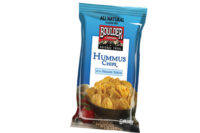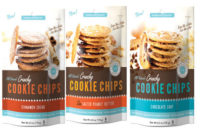Our 2013 State of the Industry report explores market information for the bread aisle, sweet goods, cookies, bars, snack cakes, frozen baked goods, tortillas, pies and more.
Bagels, muffins and pies are three baked goods categories not usually known for having healthy attributes. Bakers are changing consumers’ perceptions of these consumer favorites, though, by giving them a thorough tune-up to ensure that they remain staples of the American diet. This means incorporating more nutritious ingredients into these products; reducing sodium, fat and calories; introducing innovative flavors and flavor combinations; and offering better-tasting, gluten-free alternatives that meet the needs of a growing demographic seeking to reduce or eliminate gluten in their diet.
Bagel drivers
When it comes to bagels, bakers have been focusing on meeting specific nutritional guidelines, such as using all-natural ingredients, adding whole grains and reducing sodium.
“Most innovations are ingredient replacements,” says Dave Harris, president of Original Bagel Co. “For example, replacing non-natural ingredients with all-natural equivalents.”
The West Caldwell, N.J.-based company recently introduced Flagels, a flat bagel line, in its New York City market. Its Asiago Cheese bagels, however, are its top seller.
Launched about three years ago, Just Bagels’ Asiago bagels have been one of the Bronx, N.Y.-based company’s top sellers, too. The company uses a traditional kettle-boiled, hearth-baked method to make its products.
“From there, we stepped it up to offering a cheddar-encrusted jalapeno bagel,” says Andrew Russo, vice president of Just Bagels’ sales and marketing. “This was in response to the rise in Mexican profiles that include spicy flavors.”
In the past year, Just Bagels has added a Cheddar Cheese bagel to its robust product line, which includes more than a dozen varieties. Still, the Everything bagel remains one of the company’s top varieties. “At the end of last year, there was an increase in customer requests for our whole-wheat Everything bagels,” Russo says, adding that the company has seen “consistent growth in the bagel category over the last seven to eight years.”
Customers can add different cheese toppings to A&S Bagels Inc.’s raw-dough and par-baked bagels. “Bakers have been baking off such flavors as the Pepper Jack Cheese bagel and the Asiago Cheese bagel,” says Gregory Scolieri, vice president of the Franklin Square, N.Y., company. “We also make a Cheddar Cheese bagel with real cheddar mixed throughout the dough.” The company’s Jalapeno Cheddar Cheese bagel, which has jalapeno pieces inside and cheddar and jalapenos on top, is now available in the company’s retail store.
“We like to experiment with different flavors, and we are constantly trying out new ingredients to add to our bagel lineup,” Scolieri explains. “Our Spinach bagel has been getting more attention lately by our customers. Additionally, we make Sun-Dried Tomato bagels, Chocolate Chip bagels, Blueberry bagels and other flavors.”
A&S Bagels’ French Toast bagel, meanwhile, addresses growing consumer demand for sweet bagels. The variety has a crumb topping and lots of powdered sugar.
“As each year passes, people are seeking more creative options,” says Scoleri. “For instance, Blueberry bagels were once frowned upon by some bakers and consumers as not being a real, traditional bagel flavor. However, now more consumers want to experience different flavors, and most bakers seem to enjoy experimenting with different ingredients and flavor combinations.”
Udi’s Gluten Free in Denver, meanwhile, introduced two bagels this year that are flavorful and gluten-free. The Everything Inside bagel folds bagel toppings inside. “We also introduced the Mighty bagel,” says Denise Sirovatka, Udi’s vice president of marketing. “Given the trends in gluten-free, we wanted to offer something with more nutritional value. This bagel has 8 g. of protein,
3 g. of fiber and 14 g. of whole grains.”
The company’s research and development team is currently working with more nutritionally valuable ingredients, such as fiber and probiotics.
Muffins shift into high gear
There are two major trends in the muffin segment: One is the increasing popularity of commodity muffins due to less diet-conscious consumers seeking value. The other is the influx of healthier muffin varieties as more consumers discover that the traditional muffins they once thought of as a nutritious breakfast and snack option are typically high in calories and fat.
U-Be-Livin-Smart, a Concord, Ontario-based manufacturer of healthy foods, seeks to change muffins’ unhealthy image. Its Karma”ffin line, introduced last January, offers four nutrient-dense muffins: Belgian Chocolate with Banana, Apple Cinnamon with Chia Seed, Orange Cinnamon with Mango and Smoothie Berry Medley with Coconut.
The fat source for these products is avocadoes; other ingredients include sweet potatoes and superfruits. “We take 10 lb. of raw ingredients with no additives or preservatives and get it down to 1 lb. of finished product without losing nutrients or micronutrients,” says Tim Sinclair, U-Be-Livin-Smart’s spokesperson. “This leaves the consumer with a 130-calorie muffin that has 7 g. of protein, 3 g. of fiber and a full serving of both fruits and vegetables. We also have chosen to make it gluten- and nut-free.”
The line’s innovation also extends to its packaging. The company uses colors and graphics to help differentiate the product as being a low-calorie muffin. In addition, “one of the main packaging drivers is sustainability,” Sinclair explains. “There are reiterations of this recyclability.”
Pluses in pies
As with bagels and muffins, much of the focus in the pie segment continues to be on eliminating gluten to help expand the category and demographic.
“Obviously gluten-free is a trend that is not new to anybody, but continuing trials of new nutritional options in food is,” says Doon Wintz, president of Wholly Wholesome, a pie crust manufacturer in Chester, N.J., that makes chocolate and graham cracker pie crusts; organic whole-wheat, spelt and traditional pie shells; and a gluten-free pie shell. It’s currently working on a gluten-free pizza crust.
“This is where the trend is in this category,” says Riaz Surti, co-owner of Los Angeles-based The Original Crave Foods Co., which manufactures gluten-free pie shells and pies. “We are one of the first to offer a gluten-free pie and one of the few companies that provide it.”
The company uses garbanzo bean flour, an Indian product, combined with rice flour, rather than white or wheat flour, to make its pie shells. It’s most popular pie flavors are apple, pecan and pumpkin, but its recently introduced Chocolate Chip Cheesecake pie is also garnering a lot of interest.
“We also developed an apple cheesecake pie,” Surti says. “With gluten-free double-crusted apple pies, we need to have enough filling to create moisture. The cheesecake cream helps with this.”
The Original Crave Foods Co. also offers gluten-free Peach Cobbler, Sweet Potato and Blueberry Cream pie. Because these products use real fruit instead of thinner jelly fillings, the company has found it difficult to find machines with the viscosity to pour its fillings into the pie crusts. As a result, employees hand-scoop the fillings into the shells.
Addressing the pass-through
There’s no question that consumers are looking for more healthful products, and this has supercharged bagel, muffin and pie innovations. “[But] even this trend is shifting, as people become accustomed to products with less and no refined sugars, fats and oils that have been used in the food industry for many years,” Sinclair says, adding that, as a small company, U-Be-Livin-Smart’s production facilities can work with ingredients that may be more difficult to use but are healthier.
Nowadays, people of all ages know that foods impact how they look and feel. This is especially true for America’s aging population, which has become a force for food manufacturers to reckon with because these consumers are hyper aware of what they put in their bodies.
“There is a focus on limiting or eliminating specific ingredients that are perceived as unhealthy,” Harris says. This presents myriad challenges for bakers trying to create better-for-you products that taste good and are affordable.
“Pie has to taste good to be viable and that can be difficult [without the use of gluten],” Surti says. “The second issue is managing the costs of a gluten-free facility because it’s necessary to be certified to avoid cross-contamination.”
While healthful eating affects every baked good category, it has impacted the bagel segment in two ways. “First, for the conventional, gluten-filled category, we are seeing calorie-controlled thins enter the market,” Sirovatka says. “These are a lower calorie option for breakfast and a convenient and easy sandwich option. Second, within the gluten-free market, we are adding more nutritional value and flavor profiles that remind consumers of everyday experiences.”
The many hurdles in producing gluten-free baked goods have prevented most manufacturers from taking this route. While one gluten-free ingredient may work for one product, it doesn’t always translate into a substitution for another item. For example, gluten-free starch can be used for brownies but not for pie crust. “These products have different textures,” Surti says. “Pie crusts’ flaky texture can’t be captured with rice flour.”
In addition to the proliferation of more gluten-free baked goods, the biggest baked goods trend is the increased use of whole grains, which are more sought after than white flour.
Where flavors are concerned, consumers tend to stick with what they like. “Out of our more than a dozen bagel flavors, 80% of sales are driven by 20% of our items,” Russo says.
In the food industry in general, protein is another driver currently being focused on. “We find more and more products focusing on protein from a diet standpoint,” Wintz adds.
Down the road
Looking ahead at the bagel, muffin and pie segments, manufacturers predict continued flavor innovations, expanded gluten-free product lines and growth in items contain healthier, more nutritious ingredients.
A&S Bagels is developing more creative flavors to add to its product lineup. “The bagel market nationally has matured, and while we won’t see the solid growth of the past, bagels will maintain their market share because everyone loves a good bagel,” Harris says.
Muffins will continue evolving as they have for the last three to four years. “From a product lifecycle perspective, this is the beginning of the end of unhealthy muffins,” Sinclair adds.
Snacking offers great potential for future pie sales. “The greatest opportunity in our category is snacking,” Wintz says. “A snack that delivers nutritional value but also satisfies the desire to snack [hits the mark]. Delivering minimal ingredients, such as brown rice that provides fiber, [can make pie] a more wholesome product than potato chips.”














